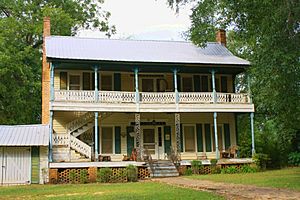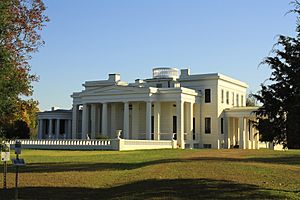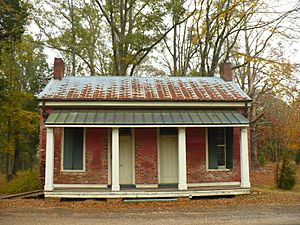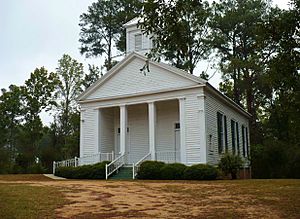Marengo County, Alabama facts for kids
Quick facts for kids
Marengo County
|
|
|---|---|
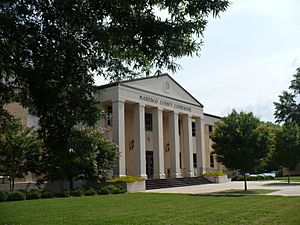
Marengo County Courthouse in Linden
|
|
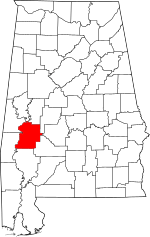
Location within the U.S. state of Alabama
|
|
 Alabama's location within the U.S. |
|
| Country | |
| State | |
| Founded | February 6, 1818 |
| Named for | Battle of Marengo |
| Seat | Linden |
| Largest city | Demopolis |
| Area | |
| • Total | 983 sq mi (2,550 km2) |
| • Land | 977 sq mi (2,530 km2) |
| • Water | 5.8 sq mi (15 km2) 0.6% |
| Population
(2020)
|
|
| • Total | 19,323 |
| • Estimate
(2021)
|
18,996 |
| • Density | 19.657/sq mi (7.590/km2) |
| Time zone | UTC−6 (Central) |
| • Summer (DST) | UTC−5 (CDT) |
| Congressional district | 7th |
|
|
Marengo County is a county located in the west central portion of the U.S. state of Alabama. As of the 2020 census, the population was 19,323. The largest city is Demopolis, and the county seat is Linden. It is named in honor of the Battle of Marengo near Turin, Italy, where French leader Napoleon Bonaparte defeated the Austrians on June 14, 1800.
Contents
History
Marengo County was created by the Alabama Territorial legislature on February 6, 1818, from land acquired from the Choctaw Indians by the Treaty of Fort St. Stephens on October 24, 1816. The name of the county commemorates Napoleon's victory at the Battle of Marengo over the Austrian armies on June 14, 1800. This name was chosen in honor of the first European-American settlers, Bonapartists exiled from France after Napoleon's downfall, who in 1817 settled the area around Demopolis. They were trying to develop a Vine and Olive Colony.
The county seat was originally known as the Town of Marengo, but in 1823 the name was changed to Linden. Linden is a shortened version of Hohenlinden, scene of the Battle of Hohenlinden, a French victory in Bavaria on December 3, 1800 during Napoleon's campaign. County courthouse fires occurred in 1848 and 1965, but most of the courthouse records were in a vault and largely saved in both instances.
Situated in Alabama's Black Belt and having a naturally rich soil, the county was developed by planters for numerous cotton plantations, dependent on the labor of a large number of slaves. The population was majority black, and overwhelmingly enslaved, decades before the American Civil War. In 1860 the population consisted of 24,409 slaves, 6761 free whites (including 944 slave owners), and one "free person of color," for a total combined population of 31,171. At this time there were 778 plantations and farms in the county.
Demopolis was home to the fourth-oldest Jewish congregation in Alabama, B'nai Jeshurun. It was established in 1858. After the American Civil War, the economy continued to be based on agriculture. In the transition to free labor, many freedmen turned to sharecropping as a way to establish some independence. They did not want to work in owner-controlled field gangs.
The population began to diminish rapidly after World War II. People left the farms for manufacturing jobs elsewhere, particularly with the wartime buildup of the defense industry on the West Coast. The movement of blacks out of Mississippi and other parts of the Deep South was considered part of their Great Migration, by which 5 million African Americans left the South from 1940 to 1970.
The former cotton fields were gradually converted to other uses. Some were used for pastures for cattle and horses, others for woodlands for timber, and others developed as commercial catfish ponds for farming grain-fed catfish. Beginning in the 1960s industry began to move into the area; and the work force started to work in paper mills, lumber mills, and chemical plants.
Geography
Marengo County is situated in the west-central area of the state. According to the U.S. Census Bureau, the county has a total area of 983 square miles (2,550 km2), of which 977 square miles (2,530 km2) is land and 5.8 square miles (15 km2) (0.6%) is water. The entire western county border is formed by the Tombigbee River and a small northwestern portion is formed by the Black Warrior River.
Major highways
 U.S. Highway 43
U.S. Highway 43 U.S. Highway 80
U.S. Highway 80 State Route 5
State Route 5 State Route 10
State Route 10 State Route 25
State Route 25 State Route 28
State Route 28 State Route 69
State Route 69
Adjacent counties
- Hale County (north)
- Perry County (northeast)
- Dallas County (east)
- Wilcox County (southeast)
- Clarke County (south)
- Choctaw County (southwest)
- Sumter County (northwest)
- Greene County (north-northwest)
Demographics
| Historical population | |||
|---|---|---|---|
| Census | Pop. | %± | |
| 1820 | 2,933 | — | |
| 1830 | 7,700 | 162.5% | |
| 1840 | 17,264 | 124.2% | |
| 1850 | 27,831 | 61.2% | |
| 1860 | 31,171 | 12.0% | |
| 1870 | 26,151 | −16.1% | |
| 1880 | 30,890 | 18.1% | |
| 1890 | 33,095 | 7.1% | |
| 1900 | 38,315 | 15.8% | |
| 1910 | 39,923 | 4.2% | |
| 1920 | 36,065 | −9.7% | |
| 1930 | 36,426 | 1.0% | |
| 1940 | 35,736 | −1.9% | |
| 1950 | 29,494 | −17.5% | |
| 1960 | 27,098 | −8.1% | |
| 1970 | 23,819 | −12.1% | |
| 1980 | 25,047 | 5.2% | |
| 1990 | 23,084 | −7.8% | |
| 2000 | 22,539 | −2.4% | |
| 2010 | 21,027 | −6.7% | |
| 2020 | 19,323 | −8.1% | |
| 2021 (est.) | 18,996 | −9.7% | |
| U.S. Decennial Census 1790–1960 1900–1990 1990–2000 2010–2020 |
|||
2020 census
| Race | Num. | Perc. |
|---|---|---|
| White | 8,375 | 43.34% |
| Black or African American | 10,133 | 52.44% |
| Native American | 6 | 0.03% |
| Asian | 54 | 0.28% |
| Pacific Islander | 1 | 0.01% |
| Other/Mixed | 386 | 2.0% |
| Hispanic or Latino | 368 | 1.9% |
As of the 2020 United States Census, there were 19,323 people, 7,361 households, and 3,833 families residing in the county.
2010 census
As of the 2010 census, there were 21,027 people living in the county. 51.7% were Black or African American, 46.4% White, 0.3% Asian, 0.2% Native American, 0.1% Pacific Islander, 0.7% of some other race and 0.8% of two or more races. 1.7% were Hispanic or Latino (of any race).
Culture
Events
- Candlelight Evening at Gaineswood, part of Christmas in the Canebrake, in Demopolis
- Christmas on the River in Demopolis
- Faunsdale Biker Rally in Faunsdale
- Alabama Crawfish Festival in Faunsdale
- Harvest Festival in Demopolis
- Historic Demopolis Spring Pilgrimage in Demopolis
- Pepper Jelly Festival in Thomaston
- Southern Literary Trail in Demopolis
Places of interest
Marengo County is home to the Alabama Rural Heritage Center and Chickasaw State Park. The Tombigbee River and Black Warrior River form portions of the western and northern county borders and provide recreational opportunities. Marengo County has 28 sites listed on the National Register of Historic Places, one of which is also a National Historic Landmark. Additionally, 19 sites are listed on the Alabama Register of Landmarks and Heritage.
Communities
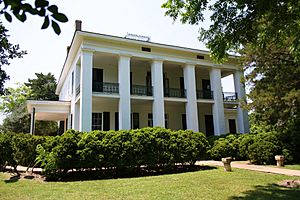
Cities
Towns
Census-designated places
Unincorporated communities
Ghost town
Education
For the 2014-15 school year, the Marengo County School District is operating three K–12 schools, one each in Dixons Mills, Sweet Water. and Thomaston. One former county school in the Demopolis area was closed by the school board following the 2013-14 school year. Demopolis and Linden have city-run school systems, the Demopolis City School District and Linden City Schools.
See also
 In Spanish: Condado de Marengo para niños
In Spanish: Condado de Marengo para niños


